ForTheArborist
Addicted to ArboristSite
When I saw these trees while I was doing a lot of other work around the property, I thought this would be an opportunity to practice my records/documentation of some questionable tree health and structure. I also couldn't just finish up the work around there, and go home with a clean conscience about ignoring these trees. They look like hell to me, so I want to do my research at AS, and make a conclusion about whether they are dangerous or not.
This first tree is a kind of eucalyptus. It's in an unusual area that is affecting it's health I think. The pictures show it's condition, but I'll describe the little spot it's in. I
t's at the bottom of a 30ft hill. I was installing some oleanders in a row down the hill side, and noticed that anywhere from 3-7 inches below shovel soft dirt there is a hard layer. First of all the dirt there is a more like a large grain of sand somewhere in between dirt and sand. Then that hard layer is not shovel soft at all. I had to use a pick, shovel it out, pick, shovel... It's like a compacted gravel sort of mix or a loose cement, and it has a high rate of a black criselus like substance consistently through it. There are trees growing in this stuff, but I question I question how well. They don't seem too healthy to me.
The tree in question is the biggest euc in the middle here below:
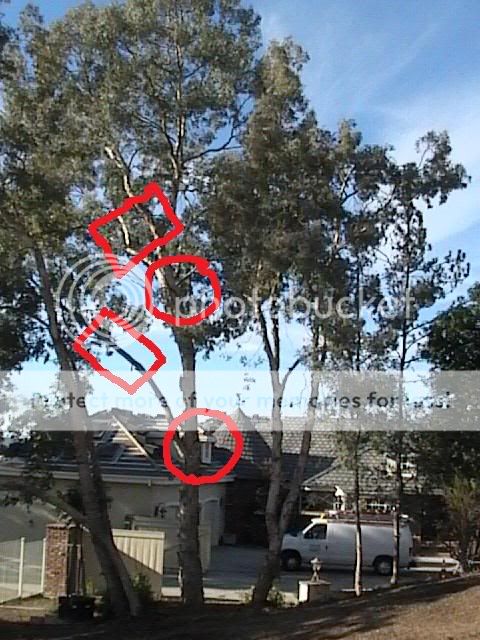
The thing is riddle with cuts and tears on its central and peripheral structure. I think that these things are a prelude to something nasty. First of all, this species gets almost twice this size. I don't see how a tree with these lacerations which are obviously augmenting can support its own weight when it's on the mature end of its life. You can see that if the top 2/3 of the tree goes over at the bottom, red circle, it's going to crush his fencing, and when it's more stories high, it's going to get his garage there on the left.
The red circles depict some of the major horizontal lacerations in the trunk, and the red squares depict some of the most significant tears running along the bottom of the branch.
Below are the pics of the biggest cut in the trunk which has me most concerned. It's the one in the lowest, red circle above:
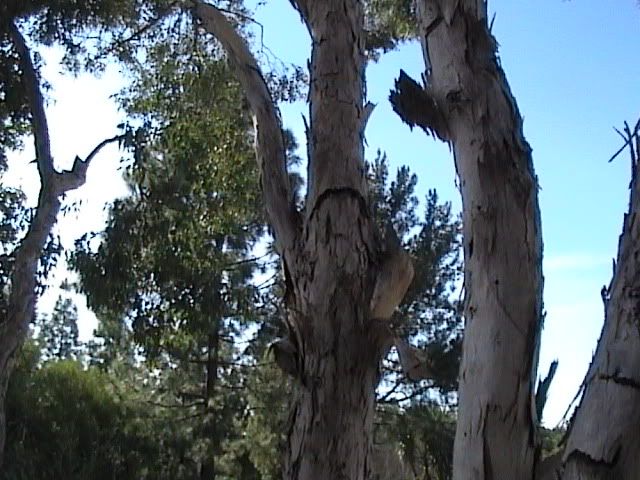
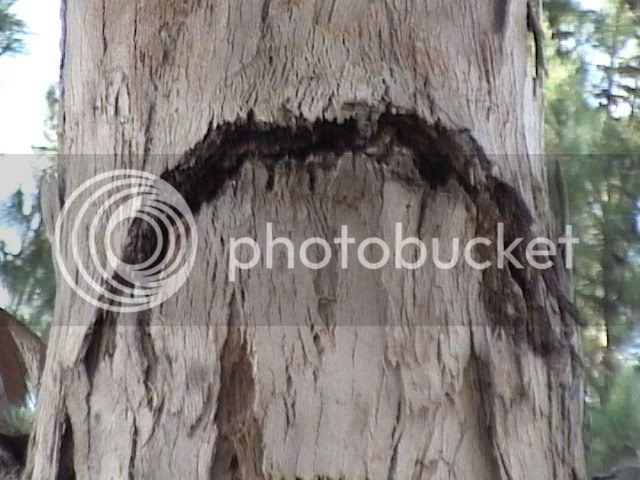
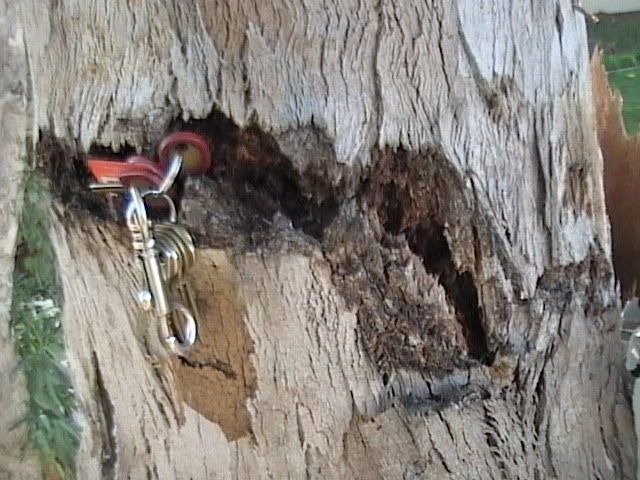
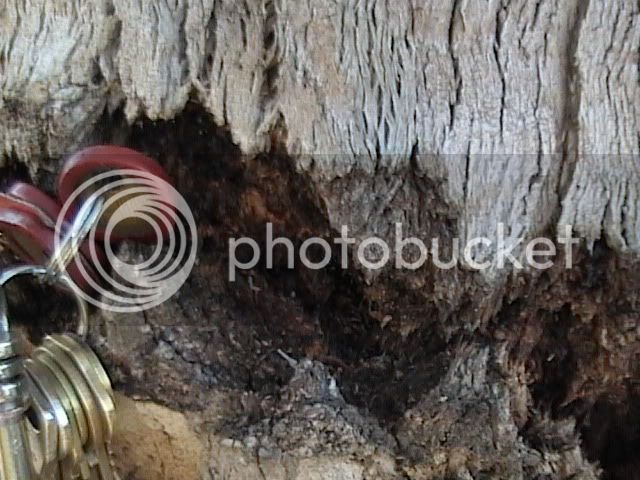
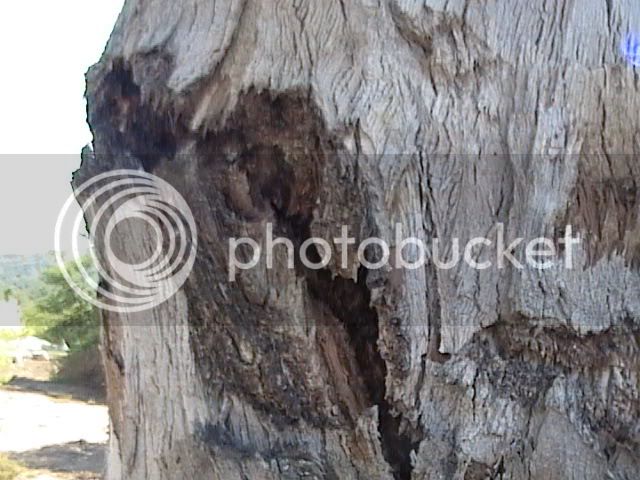
Below are only few of the many more tears and cuts through out the tree. Also I should mention the very young tree to the right of this one already has some of this in its main central structure too. There are many more of these than what I'm showing. These ought to be enough pictures to determine whether this tree is to be a future "gone with the wind" drama or these marks are natural.
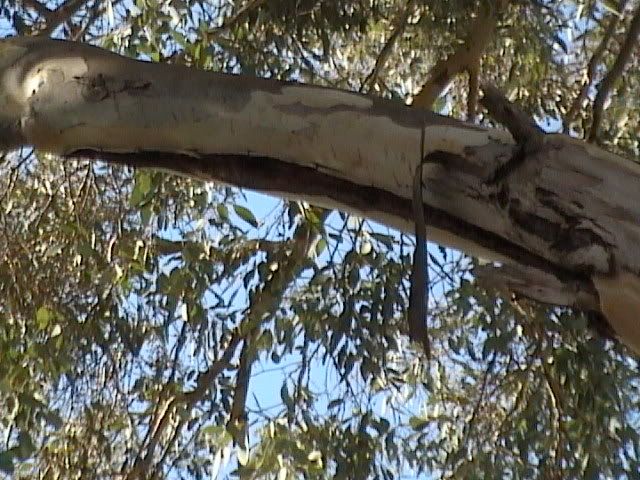
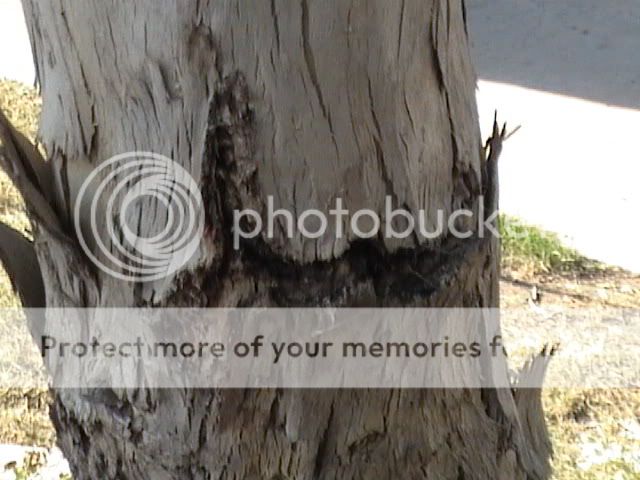
I'd remove any of these trees with these marks on them. Knowing the universal reputation of eucalyptus structure, and after working with some of them, I'd say that this is a situation of pay for the removals now, or pay for the fence and/or garage later and maybe a funeral too. I also am eager to read from some our known AS constituents out there about whether or not this is its natural pattern. Given the flakey nature of the bark/skin here these effects may be normal.
I've described the soil there at the top. The trees around seem awkward too. The oleanders near there are vey thin. Usually oleanders are flush and bushy, but you can see right through these as if they weren't even bushes at all to begin with. It's very surprising.
Then there are the two trees which have grown on their sides horizontally. One was a full sized tree like the big eucalyptus above, but it only grew up about 10ft in a few different trunks, and it grew the rest of itself along the ground taking root from the branches. We thought we were taking out a small, dead tree there at first, but as I was removing it I discovered all of the bushes behind it were this tree which spread out all over the place down there.
There is also a 35ft eucalyptus tree that grows upward only 10ft, and it grows the rest of the way horozontally. That tree is going to contiue to grow longer and onto the ground if not snap off.
There are also two pine trees that are very sickly looking near there. The needles are very, very sparse, and only the top ones have some green in them while the bottom ones are dead brown. I wasn't sure if this kind of tree could shed its needles. I've read some do.
Over all the area seems bad for any trees health. I'm not sure about the soil content, and I've watched documentaries about salt accumulation that comes with irrigation over hard soil like this. The salt kills farmers' crops here in CA. There is irrigation in these trees' area, and possibly there is similar problem for these trees. Maybe they just can't spread roots in that stuff. One last fact to consider is that about 50-70 ft away from these trees the rock bed is exposed through the soil. Possibly the underlying rock bed is not far enough down for the trees to boast of a expansive root system.
Will someone name the instances I've described here, and what you've seen or have been taught is the usual course of action for trees in this state? Thanks a million.
This first tree is a kind of eucalyptus. It's in an unusual area that is affecting it's health I think. The pictures show it's condition, but I'll describe the little spot it's in. I
t's at the bottom of a 30ft hill. I was installing some oleanders in a row down the hill side, and noticed that anywhere from 3-7 inches below shovel soft dirt there is a hard layer. First of all the dirt there is a more like a large grain of sand somewhere in between dirt and sand. Then that hard layer is not shovel soft at all. I had to use a pick, shovel it out, pick, shovel... It's like a compacted gravel sort of mix or a loose cement, and it has a high rate of a black criselus like substance consistently through it. There are trees growing in this stuff, but I question I question how well. They don't seem too healthy to me.
The tree in question is the biggest euc in the middle here below:

The thing is riddle with cuts and tears on its central and peripheral structure. I think that these things are a prelude to something nasty. First of all, this species gets almost twice this size. I don't see how a tree with these lacerations which are obviously augmenting can support its own weight when it's on the mature end of its life. You can see that if the top 2/3 of the tree goes over at the bottom, red circle, it's going to crush his fencing, and when it's more stories high, it's going to get his garage there on the left.
The red circles depict some of the major horizontal lacerations in the trunk, and the red squares depict some of the most significant tears running along the bottom of the branch.
Below are the pics of the biggest cut in the trunk which has me most concerned. It's the one in the lowest, red circle above:





Below are only few of the many more tears and cuts through out the tree. Also I should mention the very young tree to the right of this one already has some of this in its main central structure too. There are many more of these than what I'm showing. These ought to be enough pictures to determine whether this tree is to be a future "gone with the wind" drama or these marks are natural.


I'd remove any of these trees with these marks on them. Knowing the universal reputation of eucalyptus structure, and after working with some of them, I'd say that this is a situation of pay for the removals now, or pay for the fence and/or garage later and maybe a funeral too. I also am eager to read from some our known AS constituents out there about whether or not this is its natural pattern. Given the flakey nature of the bark/skin here these effects may be normal.
I've described the soil there at the top. The trees around seem awkward too. The oleanders near there are vey thin. Usually oleanders are flush and bushy, but you can see right through these as if they weren't even bushes at all to begin with. It's very surprising.
Then there are the two trees which have grown on their sides horizontally. One was a full sized tree like the big eucalyptus above, but it only grew up about 10ft in a few different trunks, and it grew the rest of itself along the ground taking root from the branches. We thought we were taking out a small, dead tree there at first, but as I was removing it I discovered all of the bushes behind it were this tree which spread out all over the place down there.
There is also a 35ft eucalyptus tree that grows upward only 10ft, and it grows the rest of the way horozontally. That tree is going to contiue to grow longer and onto the ground if not snap off.
There are also two pine trees that are very sickly looking near there. The needles are very, very sparse, and only the top ones have some green in them while the bottom ones are dead brown. I wasn't sure if this kind of tree could shed its needles. I've read some do.
Over all the area seems bad for any trees health. I'm not sure about the soil content, and I've watched documentaries about salt accumulation that comes with irrigation over hard soil like this. The salt kills farmers' crops here in CA. There is irrigation in these trees' area, and possibly there is similar problem for these trees. Maybe they just can't spread roots in that stuff. One last fact to consider is that about 50-70 ft away from these trees the rock bed is exposed through the soil. Possibly the underlying rock bed is not far enough down for the trees to boast of a expansive root system.
Will someone name the instances I've described here, and what you've seen or have been taught is the usual course of action for trees in this state? Thanks a million.






 , and other options and even basic assessment is not familiar territory to the poster. When I recommend reduction it should be understood that the work would be done by a competent climbing arborist.
, and other options and even basic assessment is not familiar territory to the poster. When I recommend reduction it should be understood that the work would be done by a competent climbing arborist.